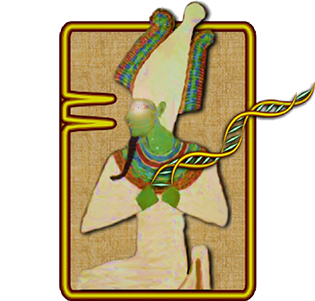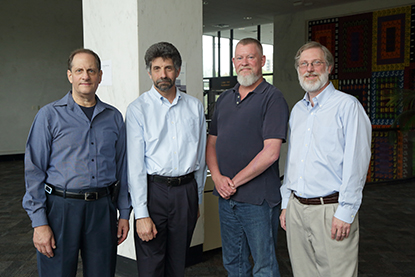New Methods
OSIRIS Prolonging Life
Homegrown Forensics

CREDIT: STEVE SHERRY, NCBI
OSIRIS logo designed by team member Steve Sherry shows the Egyptian god of the dead holding a DNA strand; frame shows STR peaks.
A software tool named after the god of the dead in Egyptian mythology and that began as a way to identify the dead is now, ironically, helping to prolong life.
In the NIH Clinical Center, OSIRIS, or the Open Source Independent Review and Interpretation System, is being used to computationally assess the quality of DNA profile data for transplant patients, saving critical time in determining whether transplants have been successful or have failed.
But OSIRIS didn’t begin as a clinical tool.
Rose Out of the Rubble
“OSIRIS started in response to the World Trade Center attacks of September 11, 2001, when the identification of most of the victims required DNA identification,” said NCBI staff scientist George Riley. “We knew the issues were addressable through software and mathematics.”
OSRIS was developed by the National Library of Medicine’s National Center for Biotechnology Information (NCBI) in collaboration with state and United States Army forensic laboratories and the National Institutes of Standards and Technology. NCBI provided funding to the National Institute of Justice, a research branch of the U.S. Department of Justice, to create software that could help in any future mass casualty in which DNA profiling was required.
When Hurricane Katrina hit New Orleans in 2005, OSIRIS was ready for beta testing and helped to identify some of the people who died.
“Just the gratitude I’ve seen from some survivors when they’ve had remains returned convinced me that it is the most privileged event I’ve had as a scientist,” NCBI staff scientist Steves Sherry told GCN.com at the time. And that’s when it clicked that OSIRIS can help the living.
Multiple Applications
To ensure high-quality interpretation of DNA profiles, OSIRIS analyzes the chromatogram (visual representation of a DNA sample produced by a sequencing machine) for peaks that correspond to different size pieces of DNA and sorts the information by location and length of short-tandem-repeat (STR) sequences. STR units are especially useful for human identification. For one thing, the number of repeats in STR markers can vary widely among individuals, making it easier to distinguish samples from one another. For another, the number of STRs can be easily amplified so there’s more material to analyze.
“Short-tandem-repeat polymerase chain reaction—that’s a fancy way of saying you copy DNA over and over again,” said Riley. “We can start with a very small amount of DNA, as little as a pinprick of blood, and wind up with a sizable amount—a billion times [as much as] you started with.”
OSIRIS has been approved by the FBI and is used in casework in state and military labs. It helps to identify victims, criminals, and missing persons, and determine paternity.
“OSIRIS can help with a lot of weird and awful crimes,” says Riley. He should know. He ran forensic DNA labs in Seattle and in Fairfax, Virginia, before joining NCBI in 2010. But for Riley, the most impressive use of OSIRIS happens at NIH in the Clinical Center.
When the Situation Isn’t Black or White
OSIRIS plays a valuable role for patients who are undergoing stem-cell transplantation for a variety of conditions including aplastic anemia, sickle-cell anemia, and some types of cancer such as leukemia, pre-leukemia, and malignant lymphomas. At various times after the transplant, the software is used to measure the percentage of donor cells in the patient’s tissues, an indication of how well the new stem cells are producing healthy blood cells.
Roger Kurlander, who runs the NIH Clinical Center’s molecular hematology lab, uses OSIRIS to monitor patients after allogenic hematopoietic stem-cell transplantation, which is the transfer of immature cells from a donor’s bone marrow or blood into another individual.

PHOTO BY ERNIE BRANSON
OSIRIS team members (left to right) Rob Goor, Doug Hoffman, Steve Sherry, and George Riley.
“OSIRIS has very sophisticated algorithms for accurately measuring changes in chimerism over time,” Kurlander said. Chimerism simply refers to an organism that’s made up of cells from two or more individuals—a transplant patient has both his own cells and the donor’s cells. “Accurate detection of these changes allows clinicians to respond quickly during the early phases of disease recurrence or graft failure,” Kurlander continued. “When the situation isn’t black and white but gray, the better your tools, the more confident you are at knowing what’s going on. OSIRIS helps build that confidence.”
“It’s not common that you get to work on life and death matters,” said Riley. “OSIRIS is used by police, people in the armed services, and doctors. [It] touches people’s lives.”
OSIRIS is a public-domain quality-assurance software package that facilitates the assessment of multiplex short-tandem-repeat (STR) DNA profiles based on laboratory-specific protocols. For more information, go to http://www.ncbi.nlm.nih.gov/projects/SNP/osiris/.
This page was last updated on Wednesday, April 13, 2022
